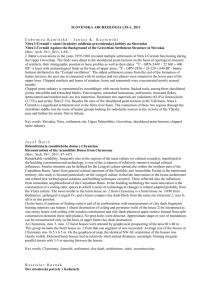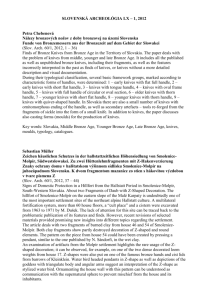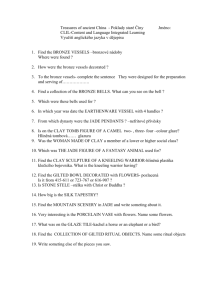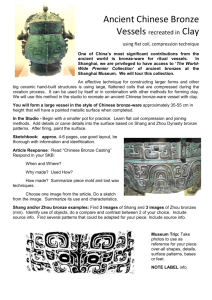vo formáte *
advertisement
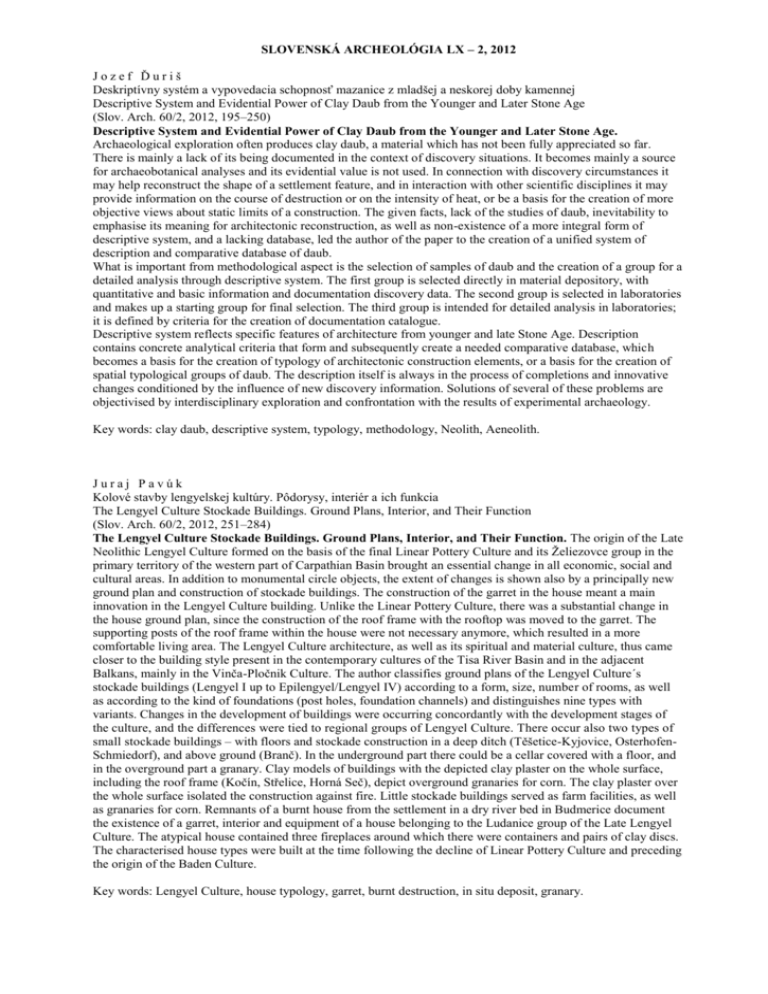
SLOVENSKÁ ARCHEOLÓGIA LX – 2, 2012 Jozef Ďuriš Deskriptívny systém a vypovedacia schopnosť mazanice z mladšej a neskorej doby kamennej Descriptive System and Evidential Power of Clay Daub from the Younger and Later Stone Age (Slov. Arch. 60/2, 2012, 195–250) Descriptive System and Evidential Power of Clay Daub from the Younger and Later Stone Age. Archaeological exploration often produces clay daub, a material which has not been fully appreciated so far. There is mainly a lack of its being documented in the context of discovery situations. It becomes mainly a source for archaeobotanical analyses and its evidential value is not used. In connection with discovery circumstances it may help reconstruct the shape of a settlement feature, and in interaction with other scientific disciplines it may provide information on the course of destruction or on the intensity of heat, or be a basis for the creation of more objective views about static limits of a construction. The given facts, lack of the studies of daub, inevitability to emphasise its meaning for architectonic reconstruction, as well as non-existence of a more integral form of descriptive system, and a lacking database, led the author of the paper to the creation of a unified system of description and comparative database of daub. What is important from methodological aspect is the selection of samples of daub and the creation of a group for a detailed analysis through descriptive system. The first group is selected directly in material depository, with quantitative and basic information and documentation discovery data. The second group is selected in laboratories and makes up a starting group for final selection. The third group is intended for detailed analysis in laboratories; it is defined by criteria for the creation of documentation catalogue. Descriptive system reflects specific features of architecture from younger and late Stone Age. Description contains concrete analytical criteria that form and subsequently create a needed comparative database, which becomes a basis for the creation of typology of architectonic construction elements, or a basis for the creation of spatial typological groups of daub. The description itself is always in the process of completions and innovative changes conditioned by the influence of new discovery information. Solutions of several of these problems are objectivised by interdisciplinary exploration and confrontation with the results of experimental archaeology. Key words: clay daub, descriptive system, typology, methodology, Neolith, Aeneolith. Juraj Pavúk Kolové stavby lengyelskej kultúry. Pôdorysy, interiér a ich funkcia The Lengyel Culture Stockade Buildings. Ground Plans, Interior, and Their Function (Slov. Arch. 60/2, 2012, 251–284) The Lengyel Culture Stockade Buildings. Ground Plans, Interior, and Their Function. The origin of the Late Neolithic Lengyel Culture formed on the basis of the final Linear Pottery Culture and its Želiezovce group in the primary territory of the western part of Carpathian Basin brought an essential change in all economic, social and cultural areas. In addition to monumental circle objects, the extent of changes is shown also by a principally new ground plan and construction of stockade buildings. The construction of the garret in the house meant a main innovation in the Lengyel Culture building. Unlike the Linear Pottery Culture, there was a substantial change in the house ground plan, since the construction of the roof frame with the rooftop was moved to the garret. The supporting posts of the roof frame within the house were not necessary anymore, which resulted in a more comfortable living area. The Lengyel Culture architecture, as well as its spiritual and material culture, thus came closer to the building style present in the contemporary cultures of the Tisa River Basin and in the adjacent Balkans, mainly in the Vinča-Pločnik Culture. The author classifies ground plans of the Lengyel Culture´s stockade buildings (Lengyel I up to Epilengyel/Lengyel IV) according to a form, size, number of rooms, as well as according to the kind of foundations (post holes, foundation channels) and distinguishes nine types with variants. Changes in the development of buildings were occurring concordantly with the development stages of the culture, and the differences were tied to regional groups of Lengyel Culture. There occur also two types of small stockade buildings – with floors and stockade construction in a deep ditch (Těšetice-Kyjovice, OsterhofenSchmiedorf), and above ground (Branč). In the underground part there could be a cellar covered with a floor, and in the overground part a granary. Clay models of buildings with the depicted clay plaster on the whole surface, including the roof frame (Kočín, Střelice, Horná Seč), depict overground granaries for corn. The clay plaster over the whole surface isolated the construction against fire. Little stockade buildings served as farm facilities, as well as granaries for corn. Remnants of a burnt house from the settlement in a dry river bed in Budmerice document the existence of a garret, interior and equipment of a house belonging to the Ludanice group of the Late Lengyel Culture. The atypical house contained three fireplaces around which there were containers and pairs of clay discs. The characterised house types were built at the time following the decline of Linear Pottery Culture and preceding the origin of the Baden Culture. Key words: Lengyel Culture, house typology, garret, burnt destruction, in situ deposit, granary. Ladislav Veliačik Nože z doby bronzovej na Slovensku Bronzezeitliche Messer aus der Slowakei (Slov. Arch. 60/2, 2012, 285–342) Knives from Bronze Age in Slovakia. The study is focused on the assessment of the production and occurrence of bronze knives in the territory of the present-day Slovakia and their typological-chronological classification. The set of the 99 whole, though more often fragmentarily preserved, analysed exemplars is a significant part of the material content of the central Danubian and Carpathian culture, and especially of the Urnfield cultures. A detailed analysis showed, however, an almost unexpectedly non-proportional representation of the analysed kind of products of bronze industry within the relics of Lusatian, central Danubian, south-eastern cultures of urnfields, with surprisingly lower occurrence in such a rich area of developed metallurgy as it existed especially in the Piliny, Kyjatice and Gáva cultures. The scale of finds clearly documents the representation of knives of all basic central European typological groups, made up by exemplars with full, frame, tongue, plate and thorn handle. In the study they are classified into twenty-five types and further variants. A part of Slovak finds displays certain formal differences which, with few exceptions (proposed types Smolenice, Čaka and Horná Seč), and also as a consequence of the finds´ frequent fragmentariness and the absence of a more significant closed whole, did not lead to the creation of new independent types. From the very beginning of the occurrence of bronze knives there were close contacts with south-eastern, and especially with western, part of central Europe. On the contrary, uniqueness can be determined only to a certain extent with the finds typical for a broader central-eastern part of central Europe, or, the Carpathian Basin – so unique in many other products of bronze metallurgy. Due to a favourable situation in the processing of bronze knives in central Europe, Slovak finds could also be classified and compared with knives from other geographical areas nowadays belonging to the territory of Bohemia, Moravia, Germany, Poland, and Austria. And their affinity, or local peculiarities, could be pointed out as well. The assessed finds inventory is significant also for the occurrence of ten casting moulds documenting local production of knives, especially in the territory of the Slovak branch of Lusatian culture. Of extraordinary importance are especially the moulds from the burial ground in Vyšný Kubín, laid over the urns with assumed graves of specialised metal founders. Knives are generally considered to be universal, multi-purpose work instruments. In addition to this function of most Slovak exemplars, there has also been consideration, especially with regard to the oldest and youngest period, of their role as attributes of more significant social status, or of their use as medical or hygienic instruments, or instruments used at ritual ceremonies. Key words: Slovakia, Bronze Age, bronze knife, typology, chronology, decoration, function, interactions. Sebastian Müller Monumente der Ahnenverehrung? Zur Deutung der Hallstattzeitlichen Grabhügel von Nové Košariská Monumenty uctievania predkov? K interpretácii halštatských mohýl na Nových Košariskách (Slov. Arch. 60/2, 2012, 343–364) Monuments of the Reverence of Predecessors? On the Meaning of Barrows of the Hallstatt Age from Nové Košariská Site. The 5 barrows of Nové Košariská are, even 50 years after their excavation, one of the key sites of the northeast alpine Hallstatt culture. In the article selected features of the burials are analysed and being set into relation with each other. Remarkable is the high diversity referring to grave construction and furnishing. The reasons for these strong differences can probably be attributed to the general developments and upheaval which are marked by the Hallstatt period. Obviously there was no set of detailed rules established with regard to the construction of elite burials. Another topic is the understanding of the grave as a whole. The current and widely accepted interpretation of the grave furnishing as a symposion is challenged and an alternative approach is presented. The elaborately only for the grave purpose crafted vessels as well as their placement within the burial can be interpreted as result of worship activities for the dead. If this interpretation is correct, the universal phenomenon of ancestor veneration could be identified as a reason for the rich and outstanding equipment of the graves. Ancestor veneration has, on a spiritual level, the function to make sure that the dead people do not disturb the life of the living and even that they support their descendants from the world beyond. In the material world the purpose of ancestor veneration can be seen in establishing or legitimizing the claim for power or for the dominance over a particular territory by a group of people. Key words: Slovakia, northeast alpine Hallstatt culture, barrows, grave furnishing, grave symposion, ancestor veneration. Jubileá Rudolf Kujovský: Životné jubileum prof. PhDr. Václava Furmánka, DrSc. (Slov. Arch. 60/2, 2012, 365–367) Václav Furmánek: Významné životné jubileum Pavla Dvořáka (Slov. Arch. 60/2, 2012, 368–370) Správa Peter Tóth: XII. medzinárodná konferencia „Doba popolnicových polí a doba halštatská“ (Slov. Arch. 60/2, 2012, 371–374) Gabriel Fusek Šesťdesiat rokov vydávania Slovenskej archeológie Sixty Years of Publishing Slovenská Archeológia (Slov. Arch. 60/2, 2012, 375–386) Petra Chebenová Register Slovenskej archeológie. Ročníky XLI (1993) – LX (2012) (Slov. Arch. 60/2, 2012, 387–426)
